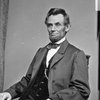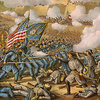Decennial Census Historical Facts
Decennial Census Historical Facts
Censuses are not conducted in a vacuum. They occur amidst internal and external crisis, shifts in cultural interests, and events that become "defining moments" for each decade. Census data reflect the growth of the population as well as the changing values and interests of the American people.
Decennial Historical Facts provides a portrait of the United States both statistically and culturally in the following four areas:
- Pop Culture – key milestones from the decade following the census.
- Population
- Census Details
- 10 Largest Urban Places
1860
ICONS: Abraham Lincoln, Civil War, Transcontinental Railroad



Population
| 31,443,321 |
U.S. Resident Population |
| 10.6 |
Population per square mile of land area |
| 35.6 |
Percent increase of population from 1850 to 1860 |
| 33 |
Number of States |
10 Largest Urban Places
| Rank |
Place |
Population |
|---|---|---|
| 1 |
New York City, NY | 813,669 |
| 2 |
Philadelphia, PA | 565,529 |
| 3 |
Brooklyn, NY | 266,661 |
| 4 |
Baltimore, MD | 212,418 |
| 5 |
Boston, MA | 177,840 |
| 6 |
New Orleans, LA | 168,675 |
| 7 |
Cincinnati, OH | 161,044 |
| 8 |
St. Louis, MO | 160,773 |
| 9 |
Chicago, IL | 112,172 |
| 10 |
Buffalo, NY | 81,129 |
The 1860 Census
| Cost | $1,969,000 |
| Cost per Capita (cents) | 6.3 |
| Total Pages in Published Reports | 3,189 |
| Number of Enumerators | 4,417 (184 office staff) |
| Census Bureau Director | Joseph C.G. Kennedy |
| Number of Questions on the Questionnaire | 14 |
| Number of Questions on the Long Form | N/A |
Pop Culture
- The Pony Express leaves Sacramento, CA, for St. Joseph, MO, on April 3, 1860.
- On February 9, 1861, after resigning from the U.S. Senate, Jefferson Davis is selected to be the provisional President of the Confederate States of America.
- Confederate forces begin bombarding Fort Sumter in Charleston Harbor on April 12, 1861.
- Poet Henry Wadsworth Longfellow publishes Paul Revere's Ride in 1861.
- President Abraham Lincoln signs the Homestead Act into law on May 20, 1862, giving applicants freehold title to land, typically 160 acres, of undeveloped federal land west of the Mississippi River.
- On September 17, 1862, the bloodiest single-day battle in American history is fought near Sharpsburg, MD, and Antietam Creek.
- The "New York City Draft Riots" rage from July 13 to July 16, 1863, following the passage of a draft law to supply men to the Union Army.
- Novelist Nathaniel Hawthorne dies on May 19, 1864, in Plymouth, NH.
- On April 14, 1865, President Abraham Lincoln is shot by John Wilkes Booth during the play Our American Cousin. Lincoln died the following morning at 7:22.
- Mark Twain publishes his first successful short story, "Jim Smiley and His Jumping Frog," in The Saturday Press on November 18, 1865.
- Russia finalizes its sale of Alaska to the United States, on March 30, 1867.
- Louisa May Alcott publishes Little Women in 1868.
- Civil War General Ulysses S. Grant beats New York Governor Horatio Seymour in the 1868 presidential election.
- Ceremonies at Promontory, UT, celebrate completion of the transcontinental railroad on May 10, 1869.
Page Last Revised - October 8, 2021




